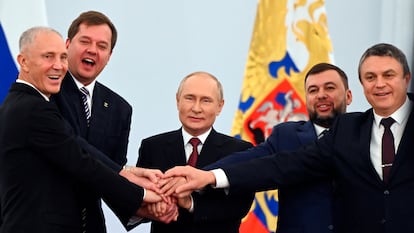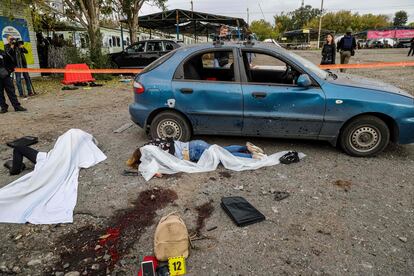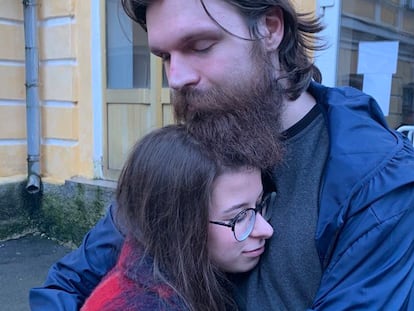Russia annexes Ukrainian territories, escalating rhetoric against the West
At least 25 people are dead and around 50 wounded after a missile attack killed civilians in Zaporizhia earlier on Friday


Russian President Vladimir Putin on Friday inaugurated a new phase in the Ukraine offensive by proclaiming the annexation of four provinces that he has illegally occupied. With their incorporation, equivalent to 15% of the Ukrainian territory, Putin has blown up the bridges to an immediate peace negotiation.
“We will defend our land with all the force and means at our disposal and we will do everything possible to ensure the safety of our people. This is the great liberating mission of our people,” Putin said to the applause of senior regime officials. The annexation, though widely anticipated for days, was met by immediate condemnation from the European Union and the United States.
The Russian president also warned that his country has embarked on a historic struggle. “The destruction of Western hegemony that has begun is irreversible. Nothing will be the way it used to be. The battlefield to which destiny and history have called us is the battlefield of our people, for a great historic Russia,” he proclaimed.
After holding pseudo-referendums in the occupied territories of Zaporizhzhia, Kherson, Donetsk and Luhansk to justify the annexation, Putin demanded from Kiyv “an immediate cease-fire and a return to the negotiating table,” although he warned that “Russia will not address at the talks the return of Donetsk, Lugansk, Kherson and Zaporizhia.” The only thing the Kremlin is offering in return is the pledge not to use its most destructive weapons in battle.
Early on Friday, Russian troops once again launched an attack on civilian targets. At least 25 people have been killed and a further 50 wounded in a missile attack on a convoy of civilian vehicles in the Zaporizhzhia region of southern Ukraine, the Prosecutor General’s Office in Kyiv said in a statement. It is the largest single civilian fatality count of the war since the massacre at the Kramatorsk train station in Donetsk on April 8, which left more than 50 people dead. The attack occurred at 7.15am local time and targeted a used vehicle market where dozens of civilian cars and vans were waiting to “leave the temporarily occupied territory, pick up their relatives and bring help,” the governor of Zaporizhzhia province, Oleksandr Staruj, confirmed via Telegram.
Air raid sirens had been sounding throughout the night and numerous explosions were heard in the area. Ukrainian anti-aircraft units worked for hours to prevent the impact of Russian missiles but three managed to get through the barrage and hit the dozens of vehicles that were waiting for a pause in the attack to resume their journeys. A huge crater, several meters deep, marks the site of the main explosion where a missile that apparently caused most of the deaths struck. “The occupiers launched 16 missiles in a single morning against Zaporizhzhia and the surrounding district. Only terrorists who have no place in the civilized world could do something like this,” Ukrainian President Volodymir Zelenskyy wrote on his Telegram account.
By mid-morning the victims of the attack, covered with blankets and plastic sheeting, had not all been removed. At least a dozen corpses were still lying on the floor – on the blanket covering one of them, where a large pool of blood had formed, the number 17 was written in black. Many more bodies remained in the vehicles they had traveling in, some of them also containing pets. People of various ages could be seen in the destroyed convoy, sitting in the front and back seats and surrounded by the possessions they had been carrying.

At least 30 cars were damaged in the attack, their windows shattered and their doors ripped out. The Ukrainian civilian and military police, as well as members of the War Crimes Prosecutor’s Office, arrived on the scene in the aftermath to begin an investigation. However, their work has been hampered by the need to keep evacuating the area: air raid sirens continued to warn of another attack throughout the day, forcing everyone to take shelter, including relatives who have been searching the devastation for family members. “We were just sitting here, and then something unexplainable happened; everything went flying,” said Natalia, a survivor of the attack. We got out of the car and ran. I don’t remember anything, I’m in shock. There are a lot of dead people. The car isn’t important. What’s important is that we are alive.”
The area targeted by the Russian bombardment is well-known. The main road running from the south of Ukraine, which follows the Dnieper River and is the most habitual route for refugees seeking to escape the occupied zones, ends there. Nearby is a disused shopping center, where the car park now serves as a reception area for NGOs, humanitarian aid agencies and Ukrainian authorities to help and process refugees arriving from the regions that were the subject of the annexation treaties signed by Putin on Friday.
Russia denies the attack
The Russian administrator of the occupied Zaporizhzhia region, Vladimir Rogov, has denied Russian forces were responsible for the massacre and blamed the attack on the Ukrainian military. “They have fired on a group of cars waiting to move to liberated territory at the exit of Zaporizhzhia,” Rogov wrote on his Telegram account.
“It is classic Anglo-Saxon provocation against a disloyal civil population,” Rogov continued, suggesting that the convoy had been hit by friendly fire so that Russia could be accused of the attack afterward. According to Rogov, the convoy “had been blocking the road for two days asking for permission [from Russia] to enter the liberated territories.”
Tu suscripción se está usando en otro dispositivo
¿Quieres añadir otro usuario a tu suscripción?
Si continúas leyendo en este dispositivo, no se podrá leer en el otro.
FlechaTu suscripción se está usando en otro dispositivo y solo puedes acceder a EL PAÍS desde un dispositivo a la vez.
Si quieres compartir tu cuenta, cambia tu suscripción a la modalidad Premium, así podrás añadir otro usuario. Cada uno accederá con su propia cuenta de email, lo que os permitirá personalizar vuestra experiencia en EL PAÍS.
¿Tienes una suscripción de empresa? Accede aquí para contratar más cuentas.
En el caso de no saber quién está usando tu cuenta, te recomendamos cambiar tu contraseña aquí.
Si decides continuar compartiendo tu cuenta, este mensaje se mostrará en tu dispositivo y en el de la otra persona que está usando tu cuenta de forma indefinida, afectando a tu experiencia de lectura. Puedes consultar aquí los términos y condiciones de la suscripción digital.
More information
Últimas noticias
Maduro pleads not guilty before the federal court in New York: ‘I am still the president of Venezuela’
A new test can detect Alzheimer’s from a finger prick
UN team enters Sudanese city of El Fasher after paramilitary massacre: ‘It’s like a ghost town’
A recipe for resistance: Indigenous peoples politicize their struggles from the kitchen
Most viewed
- Gilles Lipovetsky: ‘If you want to live better and fall in love, take Prozac, don’t look to philosophy’
- Alain Aspect, Nobel laureate in physics: ‘Einstein was so smart that he would have had to recognize quantum entanglement’
- Alvin Hellerstein, a 92-year-old judge appointed by Bill Clinton, to preside over Maduro’s trial in New York
- Why oil has been at the center of Venezuela-US conflicts for decades
- Maduro’s downfall puts China’s relationship with Venezuela to the test









































